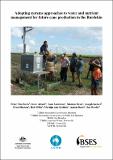| Organisation | CSIRO |
| Organisation | Sugar Research and Development Corporation |
| Organisation | BSES |
| Other Contributor | Thorburn, P |
| Date Accessioned | 2013-12-12 |
| Date Available | 2013-12-12 |
| Issued | 2008 |
| Identifier | http://hdl.handle.net/11079/13091 |
| Abstract | There is concern about environmental impacts of cropping in catchments of Australia’s Great Barrier Reef, especially losses of nitrogen (N) and herbicides from cropping systems. Sugarcane production in the Burdekin region in the dry tropics stands out from other crops/regions because, (1) it is fully irrigated, which may enhance the losses of any chemicals from farms, and (2) it has the highest N fertiliser application rates of any sugarcane producing region in Australia. There are few measurements of N and/or herbicide losses from sugarcane production, especially fully irrigated production. More complete information is needed to evaluate, develop and underpin the adoption of management practices to reduce environmental impacts of sugarcane production. Four streams of work were undertaken to provide this information: Monitoring water quality leaving sugarcane farms. Demonstrating water quality and productivity benefits of farm management practices. Harnessing the information from these two components to describe and classify management practice systems typical of past, current and future ‘best practice’, and estimate the water quality, productivity and economic benefits of these systems. Communicating results of these activities widely within and beyond the region. Water, N and herbicide losses were measured at three sites in different parts of the Burdekin region, covering a range of soil types and irrigation managements. The experimental data were then used to parameterise the APSIM-Sugarcane cropping systems model, and then used to infill missing data and develop complete water and N balances for each of the three crops measured at the sites. N losses in runoff were relatively small, being less than 10 kg N ha-1 crop-1. Herbicide losses were similar to those measured previously. More N was lost via deep drainage than runoff at all sites, even those with slowly permeable soils. The results were consistent with the known ground water nitrate contamination issues in the region. |
| Language | en |
| Part of Series | Internal Report; 2008 CSE012 |
| Related Document | http://hdl.handle.net/11079/14155 |
| Related Document | http://hdl.handle.net/11079/14156 |
| Related Document | http://hdl.handle.net/11079/14158 |
| Related Document | http://hdl.handle.net/11079/14157 |
| Related Document | http://hdl.handle.net/11079/14159 |
| Related Document | http://hdl.handle.net/11079/14160 |
| Related Document | http://hdl.handle.net/11079/14161 |
| Related Document | http://hdl.handle.net/11079/14162 |
| Subject | Water quality |
| Subject | Burdekin |
| Subject | Nitrogen losses |
| Subject | Herbicide losses |
| Subject | Productivity benefits |
| Subject | Farming management |
| Subject | APSIM |
| Subject | Cropping model |
| Subject | Environmental management |
| Subject | Water Quality Improvement Plans |
| Subject | Great Barrier Reef (GBR) |
| Title | Adopting systems approaches to water and nutrient management for future cane production in the Burdekin SRDC Research Project CSE020 final report |

